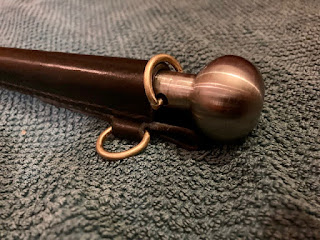During the hurricane we had last time I was on board, we lost a couple of drain grates.
The drain grates help to keep large objects out of the drain pipes from the gutter on the main deck. Large objects could be stuff like an apple or an orange or a water bottle. If they would fall into a drain pipe it would take quite some job to get them free again, so it is much better for us to prevent the blocking from happening.
The first time I was on board this ship, I made 4 drain grates, so I took upon myself to make a couple of replacements this time also. But instead of following the same procedure as last time, I decided to see if I could make them without soldering them together.
My idea was to make a brass pipe using rivets, and hammer one end so it would flare out. Then finally I would ad some pieces of copper pipe on top as the regular grate part.
I marked and cut a strip of brass sheet (1 mm / approx 3/64" thick). On one end I formed something like a rabbet, and then I bent the piece over a piece of pipe, so it ended up being round and of the correct outer diameter.
Using a piece of bronze welding rod, I made some small rivets. I would have used ready made rivets if I had some, but making them yourself is also fast.
Holes were drilled in the ends of the brass strip, and the cylinder shape was riveted together.
Using a piece of sturdy pipe as an anvil, I started hammering along one of the ends of the cylinder. The idea is to thin and thereby stretch the material so it will eventually curve out. Machines exist that can help you with that, but it is not equipment that we have on board, so the trusty hammer was the choice.
After a couple of rounds of hammering, the brass hardens. to keep it from cracking and also to make it easier to continue the forming, I annealed it using an oxygen/acetylene torch.
At a certain point the flared end almost naturally starts to bend over in a 90 degree angle to the cylinder, and that means that the forming is almost done. The only thing left is to use a flat anvil and level out the flared part.
My last design used two pieces of copper pipe bent to a 90 degree bend, and this design would also work very well with a riveted construction. So I found an old piece of copper pipe and made a couple of bends that were separated from the pipe using a pipe cutter. The ends of each bend were hammered flat and they were then riveted to the flared part of the cylinder.
The strange thing is that this way of making drain grates actually seemed faster than my previous design, and I hadn't expected that. My main reason for not soldering was actually that I wanted to see if I could use a bit less oxygen and acetylene. That was also accomplished, but the speed surprised me.
Brass plate with strip cut of (enough for two drain grates)
A riveted cylinder marked before starting the hammering.
Flared out end of the drain grate.
The two copper bends are riveted in place
Side view of the drain grate showing the rivets.
Drain grate in place in the drain pipe.




























